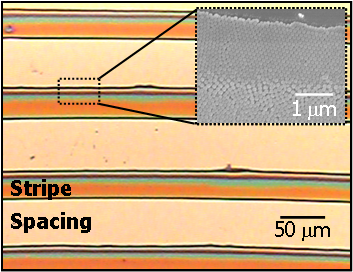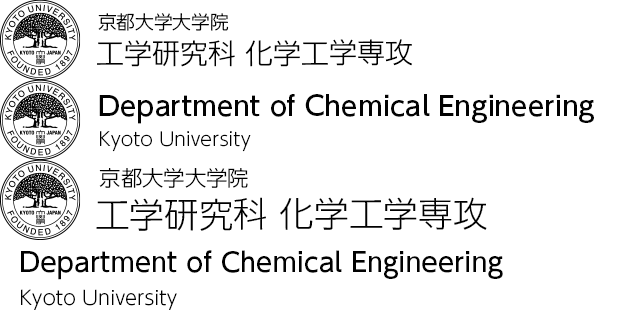Surface Control Engineering
Academic Staff
Minoru MIYAHARA
 Professor (Graduate School of Engineering)
Professor (Graduate School of Engineering)
Research Topics
For the present chemical engineering, which changes its purpose from "composition control" to "structure/function control", active use and precise control of interfacial phenomena are of crucial importance. Concerning nanoscale confined space, which enhances the interfacial effect, being pursued by him includes: behavior and structure of molecules, ions and nanoparticles arising typically in nanospace; effect of external potentials such as electric field onto those phenomena. These fundamental researches stand for potential applications to production of functional materials and various devices utilizing interfaces.
Contacts
Room 106, Bldg. A4, Katsura Campus
FAX: +81-75-383-2652
E-mail: miyahara![]() cheme.kyoto-u.ac.jp
cheme.kyoto-u.ac.jp
Satoshi WATANABE
 Associate Professor (Graduate School of Engineering)
Associate Professor (Graduate School of Engineering)
Research Topics
Structures of nanoparticles self-assembled at the solid-liquid interface are being investigated. The formation processes of 2D or 3D colloidal crystals are analyzed through experiments and computer simulations to elucidate the mechanism of the order formation and to model the processes.
Contacts
Room 101, Bldg. A4, Katsura Campus
TEL: +81-75-383-2672
FAX: +81-75-383-2652
E-mail: nabe![]() cheme.kyoto-u.ac.jp
cheme.kyoto-u.ac.jp
Shotaro HIRAIDE
Assistant Professor (Graduate School of Engineering)
Research Topics
Our research subjects include porous crystals that exhibit the adsorption-induced structural transition. We are investigating not only the mechanism of this adsorption behavior but also the separation process using these materials.
Contacts
Room 101, Bldg. A4, Katsura Campus
TEL: +81-75-383-2672
FAX: +81-75-383-2652
E-mail: hiraide![]() cheme.kyoto-u.ac.jp
cheme.kyoto-u.ac.jp
Introduction to Research
For the present-day chemical engineering, which changes its purpose from "composition control" to "structure/function control", firstly needed would be an equation, [interacting elements] x [external field] = [controlled structure]: The interacting elements such as molecules, ions and nanoparticles often exhibit peculiar behavior when placed within external potential fields of, e.g., nanospaces and solid substrates. Their structure evolution and/or phase transitions should thus be observed carefully, understood physically, and modeled quantitatively for active use of external fields originating from interfaces for controlling the structures.
Concerning nano- and submicron-scale, which enhances the interfacial effect, the researchers in this laboratory devote their efforts to the following research subjects, aiming at systematic understanding and contribution to chemical engineering fundamentals, which would stand for potential applications to production of functional materials and various devices utilizing interfaces.
1. Simulation, modeling and measurements of phase behavior in nanospace
Recent advance in nano-spaced materials has been producing fascinating porous media such as MCM-41 and metal-organic frameworks. For appropriate and extensive applications of these new media, the understanding of phase behavior of confined fluids is quite important. Exploration by molecular simulation is conducted not only for phase transitions in single-component systems, but also for binary systems. Thus obtained microscopic understandings are to be sublimated as engineering models to predict the phase behavior.

Fig. Adsorption-induced lattice transition of interpenetrating metal organic framework with jungle-gym structure
2. “Phase” behavior and structure control of nano-carbons
Knowledge about behavior of nano-carbons such as C60 and SWCNT, as a mass, remains quite limited probably because their elemental size lies between molecules and particles. Brownian dynamics, as well as molecular simulations, provide insights into their "phase" behavior within fluid media and/or on substrates. Such insights and understandings will provide possible strategy for structure control of nano-carbon masses.
3. Structure evolution by nanoparticles on adsorptive substrates or within wetting films
Ordered structures made up by 100 nm or smaller particles, or nanoparticles in the broad sense, can exhibit unique functions. The relation between operation condition and evolved structure is investigated experimentally, with the aid of the analysis by Brownian dynamics technique, which should be, in general, applied more for engineering purposes to fill the gap between microscopic analysis and macroscopic operating conditions.

Fig. Ordered stripe pattern formation of colloidal particles in wetting liquid film by evaporation-induced self-organization process.
4. Fundamental study on solid-phase evolution
The key issue for efficient production of functional materials would firstly be how to control their nucleation processes, which must determine subsequently-formed structure of a higher order. Experimental as well as theoretical studies are aiming at finding basic mechanisms of solid-phase evolution from atoms/ions/molecules under appropriate external field for targeted materials.
